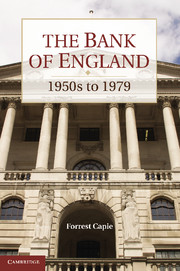Book contents
- Frontmatter
- Contents
- List of Illustrations
- List of Figures
- List of Tables
- Foreword by Mervyn King
- Preface
- Acknowledgements
- Abbreviations and Acronyms
- 1 Introduction and Overview
- 2 The Bank in the 1950s
- 3 The Monetary Setting and the Bank
- 4 The Bank's External Responsibilities to 1964
- 5 From Crisis to ‘Crucifixion’
- 6 Domestic Monetary Policy after Radcliffe
- 7 Other Activities and Performance
- 8 Sterling from Devaluation to Smithsonian
- 9 The Road to Competition and Credit Control
- 10 Competition and Credit Control
- 11 The Secondary Banking Crisis
- 12 Banking Supervision
- 13 Monetary Targets and Monetary Control
- 14 The Bank and Sterling in the 1970s
- 15 The Bank's Freedom to Operate
- 16 Epilogue
- Bibliography
- Index
- Titles in the series
16 - Epilogue
Published online by Cambridge University Press: 05 July 2011
- Frontmatter
- Contents
- List of Illustrations
- List of Figures
- List of Tables
- Foreword by Mervyn King
- Preface
- Acknowledgements
- Abbreviations and Acronyms
- 1 Introduction and Overview
- 2 The Bank in the 1950s
- 3 The Monetary Setting and the Bank
- 4 The Bank's External Responsibilities to 1964
- 5 From Crisis to ‘Crucifixion’
- 6 Domestic Monetary Policy after Radcliffe
- 7 Other Activities and Performance
- 8 Sterling from Devaluation to Smithsonian
- 9 The Road to Competition and Credit Control
- 10 Competition and Credit Control
- 11 The Secondary Banking Crisis
- 12 Banking Supervision
- 13 Monetary Targets and Monetary Control
- 14 The Bank and Sterling in the 1970s
- 15 The Bank's Freedom to Operate
- 16 Epilogue
- Bibliography
- Index
- Titles in the series
Summary
From its foundation in 1694 until the second half of the twentieth century, the Bank's basic structure had remained essentially unchanged with many of the departments, offices, and functions easily identifiable across the centuries. Nationalisation had done little to alter this, and neither had subsequent changes such as the creation of Central Banking Information Department/Economic Intelligence Department (EID) or even the end of the Discount Office. However, in the 1970s, there was a feeling that the structure was no longer suitable. In March 1980, the Bank implemented what it claimed was ‘the most radical restructuring … since 1694’.
The immediate origins are found in the summer of 1978, when Richardson discussed the subject with Blunden. Blunden identified several defects in the existing organisation: the administration was outdated, and on many matters the Governor and Executive Directors had to rely on the ‘grape-vine’ to keep themselves informed. All this was ‘a relic of the pre-1914 Bank’. Blunden felt that the Chief Cashier's role ranged too widely (whether or not he also meant that Page himself was too powerful was left unsaid); one man could not be expected to be deeply involved in credit and monetary policy and market operations while at the same time acting as the Bank's chief administrator. Again, this was an historical relic. The four Executive Directors had never been properly integrated into the structure of the Bank, and their number was determined by the 1946 Act and based on historical influences rather than organisational needs.
- Type
- Chapter
- Information
- The Bank of England1950s to 1979, pp. 823 - 834Publisher: Cambridge University PressPrint publication year: 2010



